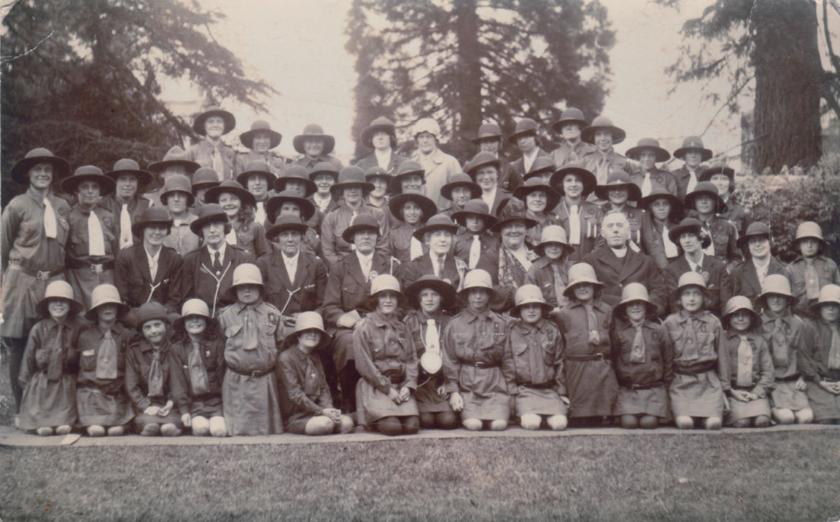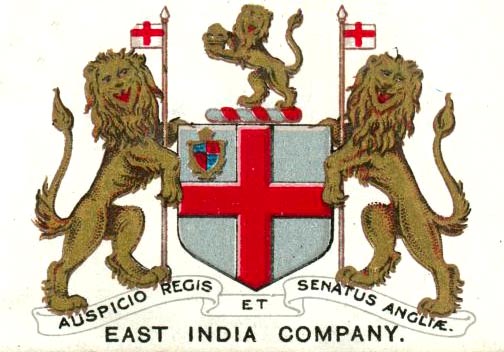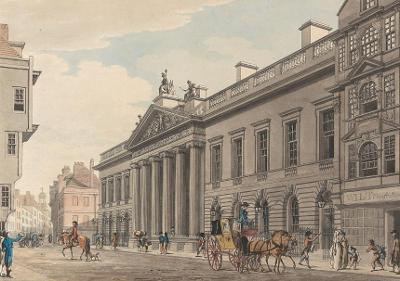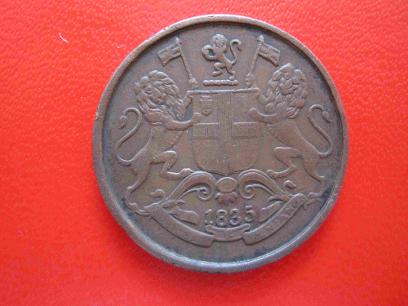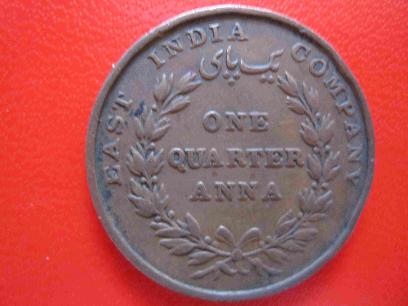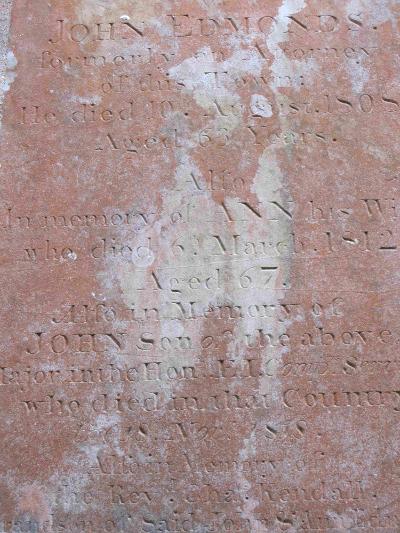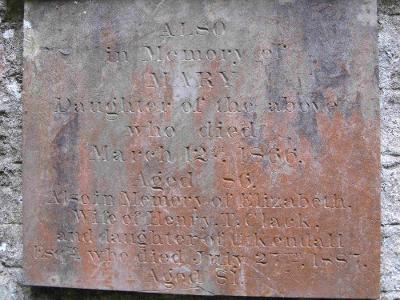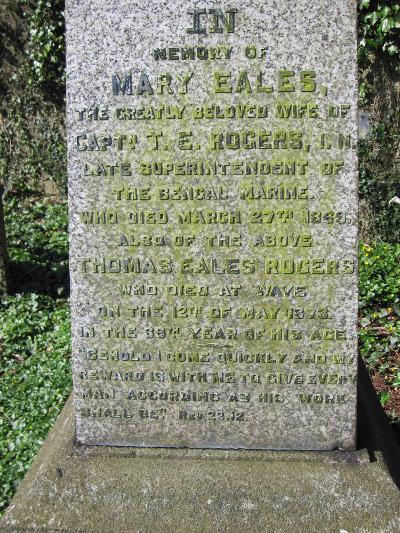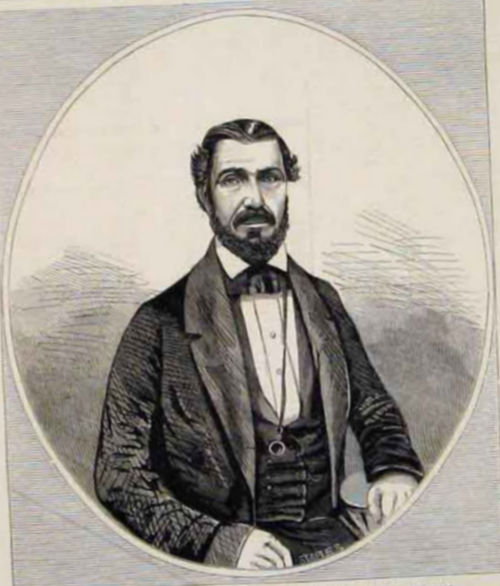Ashburton and the East India Company
Above: Arms of the British East India Company.
This image comes from a Will's cigarettes card in the collection of the New York Public Library.
With thanks to http://www.victorianweb.org/history/empire/india/eastindia.html
'The Governor and Company of Merchants of London Trading into the East Indies' were a group of merchants who banded together to gain a slice of the lucrative spice trade in the 1600s. Granted a monopoly of the English trade with the area, ships set off with goods to exchange - woollen cloth was one of these commodities.
Over time the merchants set up trading posts with the consent of the local rulers. In India three towns in particular - Bombay, Madra and Calcutta, grew in size, eventually becoming 'Presidencies'. By the mid 1700s the huge profits that the company made had transformed it from a trading concern to a ruler, a law unto itself. However, it faced power struggles with regions outside its control, and competition from other countries, notably the French and the Dutch. In spite of its wealth it struggled with the amount it had to pay for a military presence to preserve its interests.
The British government took a keen interest in the activites of such a powerful concern, and in 1773 Lord North's India Bill gave parliament greater control over the affairs of the Company. It lost its monopoly in 1833, and after the Indian Rebellion of 1857 the Crown took over complete power.
http://www.bl.uk/learning/histcitizen/trading/story/voyage/1earlyvoyages.html - Accessed 20-1-2016
http://www.victorianweb.org/history/empire/india/eic.html - Accessed 20-1-2016
https://www.sscnet.ucla.edu/southasia/History/British/EAco.html - Accessed 20-1-2016
Above: East India House, the London headquarters of the East India Company.
By Thomas Malton the Younger (1748-1804) (Yale Center for British Art [1]) [Public domain], via Wikimedia Commons
'The East India Company was first incorporated by
queen Elizabeth; their trade was laid open in the time of Oliver
Cromwell and continued so for some time...they have a governor, deputy
governor and twenty-four directors, chosen yearly at their house in
Leadenhall street. This was rebuilt in 1726, and is a large convenient
structure, with warehouses adjoining. They export fine cloth, glass,
other manufactures and bullion...they chiefly import tea, China ware,
cabinets, raw and wrought silks, coffee, spices, muslins, callicos and
other cotton cloth.'
A description of England and Wales, vol 6, London 1769, p96
1762 John Dunning (who later became Lord Ashburton - see Famous Ashburtonians) 'was employed to draw up "A defence of the United Company of Merchants of England trading in the East Indies, and their servants, particularly those at Bengal, against the complaints of the Dutch East India Company to his Majesty on that subject" which was considered as a masterpiece of language and reasoning...'
The Encyclopaedia Britannica, vol 8, Adam and Charles Black, 1842, p283
'Ordered, that there be laid before this house an account of all sums of money paid by the East India Company since the 5th day of January 1787, on account of His Majesty's Troups in the service of the said Company, according to the directions of the Act passed in the twenty first year of the reign of His present Majesty.'
The Journals of the House of Commons Nov 1787-Sept 1788, p400
'In
1787 295,311 pieces (of woollen cloth) were exported from Exeter. In
1789, the East India trade being then increasing, 121,000 pieces were
bought by the East India company alone. These were of the sort of serges
called Sandfords, except 600 pieces of broads made at Crediton; the
others were made mostly at Ashburton, Tavistock, Modbury, North Tawton
and Newton Bushel. The East India company, whilst they had the monopoly
of the tea trade, were enabled to force these pieces of serge or long
ells, on the Chinese in exchange; and it is believed, by some of the
Devonshire manufacturers, that they were induced to do this at the
request of the executive government, in order to relieve the great and
sudden distress in which the weavers and manufacturers of Devonshire had
previously been involved. From 1795 to 1805 the company annually
purchased from 250,000 to 300,000 pieces.
The Parliamentary Gazetteer of England and Wales, A Fullarton and Co., Glasgow, Edinburgh and London, 1841,Vol1, A-D, p587,588
1822 'The chief trade of Ashburton and South Molton consists in the manufacture of woollen goods for the East India Company.'
Magna
Britannia, Being a concise topographical account of the several
counties of Great Britain, Rev Daniel Lysons and Samuel Lysons, Vol 6,
Devonshire, 1822, p ccciii
The East India Company was 'a commercial body with gigantic resources, and by the force of unforeseen circumstances assumed the form of a sovereign power...'
Bentley's
Miscellany 43 (1858), quoted on The Victorian Web
http://www.victorianweb.org/history/empire/india/eic.html - Accessed
9-04-2015
Above and above right: The East India Company had its own currency.
From my own collection
After [1805] their [ie the East India company's] purchase began to
decline.....Ever since the expiration of the company's charter, the
trade has been very fluctuating, and neither so extensive nor so
regular as it had previously been: nevertheless, in 1838 serges or long
ells were still made almost at every town and village in the county,
giving employment to more than 3000 looms, of which there were, in an
around Ashburton, about 660...
...it is a remarkable fact that
since the East India company opened their contracts to public
competition, and diminished the amount of their orders, thus reducing
the wages of the weavers; the whole of this still extensive manufacture
has...fallen into the hands of women....A woman can, with the power
loom, do twice as much as a man can in a power loom (and)...it appears
to be a custom, in every trade, to pay women at a lower rate than men
for the same article...leave no alternative but the inevitable
conclusion that when this generation of weavers has passed away, women
only will find employment. There will be no weavers as a class.'
The Parliamentary Gazetteer of England and Wales, A Fullarton and Co., Glasgow, Edinburgh and London, 1841,Vol1, A-D, p588
In 1829 a letter to The Oriental Herald called for an end to the monopoly of the East India Company. 'An article in your paper tells us the East India Company have only contracted for 25,000 pieces of serges; and in consequence of which....the inhabitants of Ashburton are thrown into the greatest distress...'
The Oriental Herald and Journal of General Literature, Vol XX, 1829, p217
In 1846
serge manufacturers sent a petition (or 'memorial') to the Lords of the
Committee of Privy Council. Trade had suffered ever since the breaking
of the East India Company's monopoly* - the petitioners were looking for
support. Hoping for trade with China, the manufacturers implored their
lordships to reduce the tax on tea, to encourage a two-way flow of
goods.
Amongst the signatories were Richard and Henry Caunter, John Berry and Tozer, Sparke and Co., all of Ashburton
Western Times 9 January 1847 p6 col5
* 1833. See Help for researchers on http://www.bl.uk/
Ashburton MPs with connections to the East India Company:
Robert Palk
There are numerous accounts of Robert Palk, and most of them agree, but I have to say that so far I have found little independent evidence of his early life and career. I have added to traditional accounts where I can.
'Robert Palk came of yeoman stock
established at Ashburton, Devon. The family homestead was Lower
Headborough, the first farm out of Ashburton on the road to
Buckland-in-the-moor, and within half a mile of the town. In 1679 Walter
Palk of Ashburton, left the reversion of his lands to his nephew
Walter, son of Thomas Palk. This second Walter was succeeded by his
eldest son Walter... [who] married Frances Abraham at
Buckland-in-the-moor.'
Report
on the Palk manuscripts in the possession of Mrs Bannatyne of Haldon,
Devon, London 1922, available through https://archive.org
Robert was allegedly baptised 16 December 1717, the son of Walter and Frances. His age at death (see below) would confirm this as his birth year.
The House of Commons 1754-90, Sir Lewis Namier and John Brooke, London 1985, p245
Frances the wife of Walter Palk was buried 30th July 1740.
Parish records.
Robert Abraham, his mother's brother and Robert's godfather, is said to have sponsored Robert to attend Wadham College, Oxford after an education at Ashburton Grammar School.
A Robert and Joane Abraham were the parents of both a Robert and a Frances Abraham at Woodland (various records, 1683-90, parish records)
Robert Palk, Serviens April 1736, fil Gaulteri P. de Ashburton: pleb set 18.
The Registers of Wadham College, Oxford, Part II 1719-1871, Ed by Rev. Robert Barlow Gardner, London 1895
The above means that Robert was the son of Walter Palk of Ashburton; and possibly (I am not sure) that he had to do menial tasks at the University to work his way through.
After graduating in 1739, accounts say that Palk was ordained as a deacon at Exeter Cathedral by Bishop Weston.
'Sir Robert, early in life, took deacon's orders, which did not, however, disqualify him from a seat in parliament.'
The Gentleman's Magazine 1798, printed Fleet St., p445
He then held curacies at Egloskerry and Launcells. He then apparently went to London in 1741, attracted the favour of Robert Walpole, and was sent to India.
1742 The National Archives holds warrants or commissions for various ranks in the Royal Navy for the following: Reverend Robert Graham, Chaplain; The Hon. Edward Boscawen, Captain; Robert Heager, boatswain; Thomas Lempriere, 3rd Lieutenant; George Mackenzie, 1st Lieutenant; Richard Morgan, gunner; Reverend Robert Palk, Chaplain; Arthur Pigstock, boatswain.
http://discovery.nationalarchives.gov.uk Ref ADM 6/16/109
Five years later, in 1747, he was appointed naval chaplain to Edward Boscawen on the Namura, arriving in .
Fort St David in 1748, at time when French were in control of Fort St George in Madras.
1749 The chaplain at Fort St David, Francis Fordyce, publically insulted Robert Clive and was dismissed.
Robert
Palk took his place, but this led to some disagreements with other clergy over his
seniority. At one point he intended to resign his chaplaincy and join the
East India Company.
The trade war between the French and the British escalated into an armed fight, and General Stringer Lawrence was given the task of forming an army. Robert Palk met Stringer Lawrence in 1751, and they were to become good friends (see Stringer Lawrence's will and the letter to the Gentleman's Magazine, 1792, below).
A year later Robert was appointed as Paymaster and Commissary in the Field to Lawrence's army.
1754 saw Palk, with Henry Vansittart, discussing peace terms with the French.
Through Stringer Lawrence he was achieving lucrative deals, and the directors of the company ordered him to
confine himself to religious duties. Palk returned to England and
renounced his vows.
The East India Company continued to experience various trading
difficulties. At a meeting at the London headquarters as to who could
help, one member said, 'Gentlemen, you forget, we have Palk at home!' To
which a consensus replied, 'The very man!'
He was sent back to
India in 1761, where he served on the Council of the Company, was a member of the
treasury committee, and also served as Export Warehouse Keeper.
7 February 1761 saw the marriage of Robert Palk with Ann Vansittart by special licence at Shottesbrooke, Berkshire
Vansietart/Vansiltart in transcriptions by Berkshire FHS.
Martha Palke was baptised 28 August 1762 at Fort St George, Madras, India, the daughter of Robert and Anne Palke. Anne Palk was baptised 3 August 1764 and Lawrence Palk was baptised 6 March 1766
India Births and Baptisms, 1786-1947 database, familysearch.org
In November 1763 Robert Palk succeeded George Pigot as Governor of Madras.
The India List and India Office List 1905, Great Britain India Office, p121
1767. Robert left India, aged 50, but continued to take a great interest in any matters concerning India and the East India Company.
Catharine Palk was baptised 28 January 1768, Saint Martin in the Fields, Westminster, London and Amelia Palk was baptised 17 June 1774, St James, Westminster, London
familysearch.org
Stringer Lawrence made Robert Palk sole executor of his will. After some annuities to servants he left his 'godson Lawrence Palk the son of my
very worthy friend Robert Palk of St James' Place, esq. my sword set
with diamonds which was given to me by the East India Company* to be
delivered to him when his said father shall think him of proper age to
wear it and I give unto my godson Lawrence Palk all my plate to be
delivered to him on the day of his marriage and I give and bequeath all
the rest and the residue of my personal estate unto the said Robert
Palk...and lastly I give and devise unto the said Robert Palk...all that
messuage or tenement with the outhouses and buildings and lands and
hereditaments situate lying and being in Southampton which I lately
purchased of Mr Cox (?) and all other my real estate whatsoever.
http://discovery.nationalarchives.gov.uk 27 January 1775 PROB 11/1004/267
* This is probably the sword referred to in extracts from the minutes of the court of directors held in the National Archives, ref. IOR/H/455. It was worth £750 at the time.
In 1782 Robert Palk was made a baronet, in recognition of his efforts in securing India for Britain.
He was one of the MPs for Ashburton in 1774 and 1786 (see Election Fever, under Gathering Together)
Palk Bay and Palk Straights, a stretch of sea between India and Sri Lanka, and the Palkonda Hills near Madras were all named after him.
A letter to the Gentleman's Magazine in 1792 states the following: 'Returning on the races from Haldon to Exeter one sultry day I was induced to enter the extensive planations of Sir Robert Palke, which surround the tower lately erected by him to the memory of General Lawrence...Within the tower I found a statue of the General, copied from that in the East India House, and round the walls of the castle, which is triangular, I read with much satisfaction the following inscriptions...First Tablet. To the memory of Major General Stringer Lawrence, who, for the space of twenty years, commanded the British armies in India...This column was erected in 1788, by Sir Robert Palk, baronet, some time Governor of Madras, an eye-witness of the triumphs in war, and of the virtues in peace...
The Gentleman's Magazine, 1792, vol62, London, pp844, 845
April 29th 1798. 'At his seat at Haldon House, Devon, in his 81st year, Sir Robert Palk, bart., many years MP for Ashburton, in that county, and created a baronet March 25 1782... He married Anne, daughter of Mr Vansittart, of Shottisbrook, Berks, by whom he had Anne, married 1786 to Sir Bourchier Wrey, bart; Lawrence, so called after the general of that name, who left him his fortune, Catherine and Emelia, who both died young, the latter 1786. He is succeeded by his only son Lawrence P esq., who was chosen, at the last general election, one of the members for Devonshire, as he had before represented Ashburton.'
The Gentleman's Magazine 1798, printed Fleet St., p445
His will is held at the National Archives
http://discovery.nationalarchives.gov.uk Ref PROB 11/1308/33
Walter Palk
'This gentleman possesses a house in the neighbourhood of this town, and several estates in the county. We understand that he has been in the East Indies, and that he is a partner in an eminent banking house in Exeter.'
Memoirs of Eminent English Statesmen, published by Thomas Tegg, London, 1805, p417
Sir Hugh Inglis
'Died
Aug 21*, at his house in Queen Anne Street, London, Sir Hugh Inglis,
Bart, of Milton Bryant, Bedfordshire, in the 77th year of his age. He
went to the East Indies in 1762 and returned in 1775. Having been chosen
a Director of the East India Company in 1784 he served deputy chairman
in 1796-7, and chairman in 1797-8; again deputy chairman in 1799-1800,
and chairman in 1800-1801; and was appointed Colonel of the 2d regiment
of the Royal East India Volunteers. In June 1801 he was created a
Baronet; and in 1802 was elected MP for Ashburton. Sir Hugh Inglis was a
man of singular excellence, and of uniform consistency of conduct in
all the relations of life; of great gentleness of manners, disciplined
and improved by many Christian graces.'
The New Monthly Magazine, Volume 14 p592
*1820. He was born in 1744
Mr John Sullivan, Feb 1811 - Aug 1818
Born 1749, died 1849
'The Right Honourable John Sullivan of Ritchin's Park, Berks (MP for Ashburton, a Commissioner for the affairs of India, and brother-in-law by marriage to the Earl of Buckinghamshire) is brother to Sir Benjamin. A third brother was Richard-Joseph, who early in life was sent to Asia with his brother John, under the auspices of Laurence Sullivan, esq., FSA Chairman of the East India Company and MP first for Taunton, and afterwards for Ashburton.
Literary Anecdotes of the 18th Century, William Bowyer, John Nichols, vol IX, London 1815, p51
And other Ashburtonians with involvement in the Company:
Solomon Earle, baptised Ashburton February 1751
https://familysearch.org
To read his story go to http://freepages.genealogy.rootsweb.ancestry.com/~desmier/earle_family.html - Accessed 5-11-2016
Dr. Robert Adams has written a book about Solomon's life, and how it fits into the broader historical context. Power
and Conflict in Eighteenth Century India: The Life of Solomon Earle,
Dr. Robert Adams, York 2019 is available from www.yps-publishing.co.uk
***
Peter
Cranch, formerly of Ashburton, left a will that was proved in 1771. A
member of the 79th Regiment of Foot, he was living in Batavia in the
East Indies at the time of writing the will in 1764. When the will was
proved Peter was described as being formerly a Lieutenant in the 79th
Regiment, but later a captain in the service of the Honourable East
India Co. on the coast of Coromandel.
PROB 11/973, file reference: 82, records of the Prerogative Court of Canterbury.
There
is a transcript of the will by Kathryn Barnett at
http://www.genuki.org.uk/big/eng/DEV/Ashburton/PeterCranch1771 -
Accessed 06-08-2017 ***
William Eales was baptised at Ashburton in June 1773, the son of Richard and Winifred.
Parish records
He attended Exeter College, Oxford, and became a chaplain in the EICS. He married Catherine Raban in 1808 in Calcutta - she died in 1819 and is buried in Calcutta.
Joseph Jackson Howard and Frederick Arthur Crisp, Visitation of England and Wales notes, vol 2, 1897, Pedigree of Eales
By 1851 he was living at Waye House, Ashburton, where his daughter, Winifred E Eales, was with him on the census. He was a retired chaplain, EI Service; Winifred, aged 40, had been born in the East Indies.
1851 census HO107, piece no 1871, folio 346, p15
He died in December 1854, and was buried at Ashburton in January 1855, aged 81.
Parish records
His will was proved in the PCC in the same month.
National Archives, Ref PROB 11/2204/18, https://discovery.nationalarchives.gov.uk/details/r/D57949
***
'1792 Ashburton, April 5th
This epitaph, which I had written with an intention of placing it in the church of Ashburton, is at your service, if you see anything in it which may render it not undeserving a place in your magazine..."In the vault beneath are deposited the remains of Mrs Katharine Palk, daughter of Thomas Pelling esquire, of Madras in the East Indies, and wife of Thomas Palk esquire, of this parish. She died the 11th day of February, 1790, aged 29. An artless innocence, an active and refined benevolence..." '
The Gentleman's Magazine, vol 62, London, 1792, p464
***
'On the western side of this transept [the north transept] are three tablets...2nd. In that of "Ann, wife of Captn. John Lawrie, H E I C S, who died at Seroor, East Indies, Jany. 30th, 1820, aged 19." '
'Deaths. At Seroor, on the 28th ult., the Lady of Lieut. Lawrie, Deputy Commissary of Stores.'
Ashburton and Its Neighbourhood, Charles Worthy, Ashburton 1875, p27
The European Magazine and London Review, vol 78, July to December 1820, London, p184
* *** *
* The Edmonds family *
John Edmonds married Ann Soper by banns in February 1768
John Edmonds, son of John and Anne, was baptised on January 7th 1778 at Ashburton.
Parish records
The memorial stone below, on the wall of St Andrew's Church, says that John (Jnr) became a major in the East India Company and died in India in 1818.
According to The New Monthly Magazine and Universal Register, below right, Ann, a sibling of John, married Col. John Hilley Symons of the E.I.C.
In 1837 a case in chancery involved Williams v Symons. Any creditors of John Hilley Symons, a Major General of the Honourable East India Company, had to prove the debts or lose their claim. John Hilley Symons, of Stanbro House, Halewell*, Devon, had died circa June 1st, 1831
Exeter and Plymouth Gazette 18 November 1837, p1 col1
*Halwell?
Above: 'John Edmonds, formerly an attorney of this town He died 10th August 1808 aged 63 years.
Also in memory of Ann his wife who died 6th March 1812 aged 67
Also in memory of John son of the above Major in the Hon E I Comp. Serv who died in that country 18th November 1818
Also in memory of the Revd Cha. Kendall grandson of said John and Ann Edmonds'
1817
At Stoodleigh, Col. John Hilley Symons, of the E.I.C's service, to
Ann, eldest daughter of the late John Edmonds Esq. of Ashburton.
The New Monthly Magazine and Universal register, Vol VII January to June 1817, p260
Above: 'Also in memory of Mary daughter of the above who died March 12th 1866 aged 86
Also in memory of Elizabeth wife of Henry T. Clack and daughter of C Kendall Esq. who died July 27th 1887 aged 81'
Charles
Kendall married Elizabeth Edmonds in January 1805.
Charles Kendall
(Jnr), and Elizabeth, son and daughter of Charles and Elizabeth, were both baptised at Ashburton in
September 1806
Parish records
* *** *
Ann
Higgins, the third daughter of John Higgins Esq., Ashburton, married
Lieut. John Laurie, of the Honourable Company's Artillery and Deputy
Commissary of Ordnance, in December 1819. The marriage took place in
Bombay.
Bombay Gazette, 22 December 1819, p3 col2
1827. Obituary. Devon - Lately. At Ashburton, Lieut-Col C T Higgins, E I C
The Gentleman's Magazine, vol 97, London, July - December 1827, p92
'Deaths, Jan 25th 1831 In his 71st year, Mr John Hearn*, in the E I Company's service, formerly of Ashburton.'
The Asiatic Journal, vol IV, Jan-April 1831, London, p170
*Hern in the Exeter and Plymouth Gazette, 5 February 1831, p2 col4
Susan
Higgins, the youngest daughter of the late John Higgins Esq.,
Ashburton, married William Leggett of the 1st Troop H. A. in June 1836.
The marriage took place at St Thomas's church.
Bombay Gazette 11 June 1836, p2 col1
In August 1854 Lieutenant John Eales Caunter of the Hon East India Company Service, married Miss Fanny Ashford at Woodbury near Exeter. John was the only son of John Caunter of Ashburton.
Western Times 26 August 1854, p5 col2
George Young, 'late a colonel of the HEICS', died on the 14th March, 1860; he was 70 years old. His widow was Winifred Emma, who was a daughter of the Reverend William Eales - he had been a chaplain with the HEICS (see above). Winifred died in March 1887, aged 76.
Memorial inscription
Mr Charles Lushington
'Lushington, Ashburton. Charles Lushington Esq., formerly chief secretary to the government of Bengal, is third son of the late Sir Stephen Lushington, Bart, and brother to the member for Tower Hamlets. He was born in 1785 and is married to Sarah, daughter to Lieutenant-Colonel Joseph Gascoyne. He acts with the extreme Liberal party.'
The Assembled Commons 1836, London, 1836, p116
He died in 1866. 'The deceased was a member of a family celebrated for their services in the East Indies...Like many others of his family in past and present generations he early entered the civil service of the East India Company, and closed a successful career as chief secretary to the government of Bengal, after a period of twenty seven years from the date of his first appointment in the year 1800... The late Mr Charles Lushington entered parliament as representative of Ashburton in 1833, and sat for that place in the Liberal interest until 1841...The deceased gentleman, who formerly resided in the neighbourhood of Edgeware, was the author of "A remonstrance to the Bishop of London in behalf of the dissenters." '
The Gentleman's Magazine, Vol II July-December 1866, London, 1866, p692
In Ashburton Churchyard is a memorial which reads as follows: 'In memory of Mary Eales, the greatly beloved wife of Capt T E Rogers I.N. late superintendent of the Bengal Marine, who died March 27th 1862 also of the above Thomas Eales Rogers who died at Waye on the 13th May 1873 in the 69th year of his age.'
In 1840 Thomas Eales Rogers was one party
named in connection with the lease of a dwelling house in Landrake,
Cornwall. The Earl of Mount Edgcumbe is another.
http://crocat.cornwall.gov.uk, ref ME/1159
Thomas married 4 times, the first being to Emblyn Middleton in Calcutta, in 1845.
They had two children: Emblyn Ellen, born in Calcutta in 1846, and Thomas Middleton, born in Alipore in 1847.
Transcript of British India Office Army and Navy pensions, ref L/AG/23/18/3 f.31
Right: Memorial to Thomas and Mary Eales Rogers
My own photograph 2016
After Emblyn (his wife)'s death he married again in 1852, this time to Sarah Coates, a widow. This marriage was also in Calcutta.
John Eales Rogers was born in 1853, and a daughter, Sarah Jane, was born in Calcutta in 1854.
Sarah (the wife) died in 1855.
Transcript of British India Office Army and Navy pensions, ref L/AG/23/18/3 f.31
British India Office Ecclesiastical Returns, births and baptisms, ref N-1-83, folio 242
British India Office Pension registers, Indian Navy fund. Archive ref L-AG-23-18-2
In 1845 Thomas was a Master Attendant at Calcutta; by 1852 he was Superintendent of Marine.
British India Office Ecclesiastical Returns, parish register transcripts from the Presidency of Bengal, ref N-1-68, folio 236 and ref N-1-81, folio 114.
What was the Bengal marine?
The East India Company had a navy to protect its assets
at sea - for most of its history it was called the Bombay marine, before
becoming the Indian Navy in 1830. Little has been written about the
Bengal marine, but it appears to have been a smaller force operated by
the company from the late 1600s to 1858.
British Naval Swords and Swordsmanship, John McGrath and Mark Barton, Pen and Sword Books 2013, p69
'Although Bengal possesses a considerable extent of sea coast...she has but few good harbours; her situation, nevertheless, is well adapted for foreign commerce...Calcutta, the political and commercial capital of British India, as well as the emporium of Bengal, is situated on the Houghly river, or western branch of the Ganges, about 100 miles from the sea, and accessible to ships of all sizes and at all seasons.'
The Philosophical Magazine, Alexander Tilloch, vol 21, London, 1805, p327ff
One of the main duties of the Bengal marine seems to have been to escort ships arriving in and departing from the area. 'The Bengal Marine consists of seven pilot vessels and four steam vessels.'
Alexander's East India and Colonial Magazine, vol 10, July - December 1835, London, p468
Reports to the House of Lords give more information:
'Dockyards. There is a small yard for the Bengal marine at Kiddepore.'
Reports
by James Cosmo Melvill: 'The vessels employed in the Bengal marine are
officered and manned under arrangements made by the Bengal
government...the Bengal marine is a separate naval service, and has no
connection with the Indian Navy...they are employed in the same way as
the Indian navy [but] the pay of the officers...is lower...they are not
under martial law, except in war...it has been repeatedly suggested from
home that they should form part of the Indian navy...'
The Sessional Papers printed by order of the House of Lords, 1852-53, vol 30, pp57, 128
'Fort William, Foreign Department, October 23rd, 1852. The most noble the Governor-General in Council has much gratification in publishing for general information despatches...which report the capture and occupation of the city of Prome, after some resistance and with comparatively trifling loss...The steam squadron and boats of Her Majesty's ships, conveying the troops upon the Irrawaddy, anchored off Prome on the 9th October. A fire from the shore was silenced by the fire of the steamers and of the boats. The troops having been landed, drove the enemy, some three or four thousand strong, from the suburbs; and on subsequently advancing to the great pagoda and to the heights beyond, they found the position wholly abandoned by the Burman force...
To the officers, seamen, and marines of Her Majesty's ships, of the Indian navy and of the Bengal marine, who have been serving upon the Irrawaddy...the Governor-General in Council is desirous of offering his hearty thanks.'
Bulletins and other State Intelligence for the year 1852, Compiled and arranged from the official documents published in the London Gazette by Francis Watts, London 1853, p1021ff
A list of the Naval Force employed at the occupation of the city of Prome on the 9th and 10th of October includes:
Fire Queen, Bengal Marine, 8 guns
Enterprise, Bengal Marine, 6 guns
Mahanuddy, Bengal Marine, 4 guns
Nemesis, Bengal Marine, 6 guns
Proserpine, Bengal Marine, 6 guns
Phlegethon, Bengal Marine, 6 guns'
ibid, p 126ff
Above: 'Captain Rogers, Late superintendent of the Bengal Marine'.
Illustrated News of the World, 11 June 1859, p357
By 1859 Thomas was back in the UK: he married widow Mary Caunter in the Newton Abbot registration district in 1859.
http://www.freebmd.org.uk
In February 1860 he became Captain of the 9th Devon Rifle Volunteers.
London Gazette 2 March 1860, p899
In the 1861 census the couple are living at Waye, with
Thomas's stepdaughter Grace Caunter, aged 35, his brother and two
nieces. Thomas was born in Callington, Cornwall, and Mary was born in
the East Indies.
http://www.freecen.org.uk
After Mary's death Thomas married Harriet Eliza Poingdestie or Poingdestre in Hampstead in 1870.
They had a daughter, Mabel Milsom, born in 1871, and another daughter, Winifred Eales, born the following year. Both were baptised in Ashburton, with their father's occupation being given as 'Officer in the Indian Navy'.
http://www.freebmd.org.uk and Parish records
In 1874 Harriet Eliza is named on a document as the widow and executrix of Thomas Eales Rogers.
In his will Thomas left £3000 to his second son John Eales Rogers, with the rest of his estate going to Harriet.
http://www.freebmd.org.uk
http://discovery.nationalarchives.gov.uk, North Devon Record Office, ref 435Z/T2
British India Office Wills and Administrations ref L-AG-34-29-119
